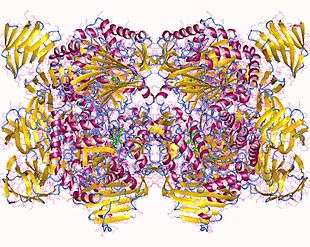Alpha-glucosidase
| Alpha-glucosidase | |||||||||
|---|---|---|---|---|---|---|---|---|---|
|
Alpha-glucosidase hexamer, Sulfolobus solfataricus | |||||||||
| Identifiers | |||||||||
| EC number | 3.2.1.20 | ||||||||
| CAS number | 9001-42-7 | ||||||||
| Databases | |||||||||
| IntEnz | IntEnz view | ||||||||
| BRENDA | BRENDA entry | ||||||||
| ExPASy | NiceZyme view | ||||||||
| KEGG | KEGG entry | ||||||||
| MetaCyc | metabolic pathway | ||||||||
| PRIAM | profile | ||||||||
| PDB structures | RCSB PDB PDBe PDBsum | ||||||||
| |||||||||

Alpha-glucosidase (EC 3.2.1.20, maltase, glucoinvertase, glucosidosucrase, maltase-glucoamylase, alpha-glucopyranosidase, glucosidoinvertase, alpha-D-glucosidase, alpha-glucoside hydrolase, alpha-1,4-glucosidase, alpha-D-glucoside glucohydrolase) is a glucosidase located in the brush border of the small intestine that acts upon α(1→6) bonds.[1][2][3][4][5][6] This is in contrast to beta-glucosidase. Alpha-glucosidase breaks down starch and disaccharides to glucose. Maltase, a similar enzyme that cleaves maltose, is nearly functionally equivalent.
Other glucosidases include:
Mechanism
Alpha-glucosidase hydrolyzes terminal non-reducing (1→4)-linked alpha-glucose residues to release a single alpha-glucose molecule.[7] Alpha-glucosidase is a carbohydrate-hydrolase that releases alpha-glucose as opposed to beta-glucose. Beta-glucose residues can be released by glucoamylase, a functionally similar enzyme. The substrate selectivity of alpha-glucosidase is due to subsite affinities of the enzyme’s active site.[8] Two proposed mechanisms include a nucleophilic displacement and an oxocarbenium ion intermediate.[8]

- Rhodnius prolixus, a blood-sucking insect, forms hemozoin (Hz) during digestion of host hemoglobin. Hemozoin synthesis is dependent on the substrate binding site of alpha-glucosidase.[9]
- Trout liver alpha-glucosidases were extracted and characterized. It was shown that for one of the trout liver alpha-glucosidases maximum activity of the enzyme was increased by 80% during exercise in comparison to a resting trout. This change was shown to correlate to an activity increase for liver glycogen phosphorylase. It is proposed that alpha-glucosidase in the glucosidic path plays an important part in complementing the phosphorolytic pathway in the liver’s metabolic response to energy demands of exercise.[10]
- Yeast and rat small intestinal alpha-glucosidases have been shown to be inhibited by several groups of flavonoids.[11]
Structure

Alpha-glucosidases can potentially be split, according to primary structure, into two families.[8] The gene coding for human lysosomal alpha-glucosidase is about 20 kb long and its structure has been cloned and confirmed.[12]
- Human lysosomal alpha-glucosidase has been studied for the significance of the Asp-518 and other residues in proximity of the enzyme’s active site. It was found that substituting Asp-513 with Glu-513 interferes with posttranslational modification and intracellular transport of alpha-glucosidase’s precursor. Additionally, the Trp-516 and Asp-518 residues have been deemed critical for the enzyme’s catalytic functionality.[13]
- Kinetic changes in alpha-glucosidase have been shown to be induced by denaturants such as guanidinium chloride (GdmCl) and SDS solutions. These denaturants cause loss of activity and conformational change. A loss of enzyme activity occurs at much lower concentrations of denaturant than required for conformational changes. This leads to a conclusion that the enzyme’s active site conformation is less stable than the whole enzyme conformation in response to the two denaturants.[14]
Disease relevance
- Pompe disease: a disorder in which alpha-glucosidase is deficient. In 2006, the drug alglucosidase alfa became the first released treatment for Pompe disease and acts as an analog to alpha-glucosidase.[15] Further studies of alglucosidase alfa revealed that iminosugars exhibit inhibition of the enzyme. It was found that one compound molecule binds to a single enzyme molecule. It was shown that 1-deoxynojirimycin (DNJ) would bind the strongest of the sugars tested and blocked the active site of the enzyme almost entirely. The studies enhanced knowledge of the mechanism by which alpha-glucosidase binds to imino sugars.[16]
- Diabetes: Acarbose, an alpha-glucosidase inhibitor, competitively and reversibly inhibits alpha-glucosidase in the intestines. This inhibition lowers the rate of glucose absorption through delayed carbohydrate digestion and extended digestion time. Acarbose may have the capability to stop developing diabetic symptoms.[17] Hence, alpha-glucosidase inhibitors (like acarbose) are used as anti-diabetic drugs in combination with other anti-diabetic drugs. Luteolin has been found to be a strong inhibitor of alpha-glucosidase. The compound can inhibit the enzyme up to 36% with a concentration of 0.5 mg/ml.[18] As of 2016, this substance is being tested in rats, mice and cell culture.
- Azoospermia: Diagnosis of azoospermia has potential to be aided by measurement of alpha-glucosidase activity in seminal plasma. Activity in the seminal plasma corresponds to the functionality of the epididymis.[19]
- Antiviral agents: Many animal viruses possess an outer envelope composed of viral glycoproteins. These are often required for the viral life cycle and utilize cellular machinery for synthesis. Inhibitors of alpha-glucosidase show that the enzyme is involved in the pathway for N-glycans for viruses such as HIV and human hepatitis B virus (HBV). Inhibition of alpha-glucosidase can prevent fusion of HIV and secretion of HBV.[20]
See also
References
- ↑ alpha-Glucosidases at the US National Library of Medicine Medical Subject Headings (MeSH)
- ↑ Bruni, C.B.; Sica, V.; Auricchio, F.; Covelli, I. (1970). "Further kinetic and structural characterization of the lysosomal α-D-glucoside glucohydrolase from cattle liver". Biochim. Biophys. Acta. 212 (3): 470–477. doi:10.1016/0005-2744(70)90253-6. PMID 5466143.
- ↑ Flanagan, P.R.; Forstner, G.G. (1978). "Purification of rat intestinal maltase/glucoamylase and its anomalous dissociation either by heat or by low pH". Biochem. J. 173 (2): 553–563. PMID 29602.
- ↑ Larner, J.; Lardy, H.; Myrback, K. (1960). "Other glucosidases". In Boyer, P.D. The Enzymes. 4 (2nd ed.). New York: Academic Press. pp. 369–378.
- ↑ Sivikami, S.; Radhakrishnan, A.N. (1973). "Purification of rabbit intestinal glucoamylase by affinity chromatography on Sephadex G-200". Indian J. Biochem. Biophys. 10 (4): 283–284. PMID 4792946.
- ↑ Sørensen, S.H.; Norén, O.; Sjöström, H.; Danielsen, E.M. (1982). "Amphiphilic pig intestinal microvillus maltase/glucoamylase. Structure and specificity". Eur. J. Biochem. 126: 559–568. doi:10.1111/j.1432-1033.1982.tb06817.x. PMID 6814909.
- ↑ "EC 3.2.1.20". ExPASy. Retrieved 1 March 2012.
- 1 2 3 Chiba S (August 1997). "Molecular mechanism in alpha-glucosidase and glucoamylase". Biosci. Biotechnol. Biochem. 61 (8): 1233–9. doi:10.1271/bbb.61.1233. PMID 9301101.
- ↑ Mury FB, da Silva JR, Ferreira LS, et al. (2009). "Alpha-glucosidase promotes hemozoin formation in a blood-sucking bug: an evolutionary history". PLoS ONE. 4 (9): e6966. doi:10.1371/journal.pone.0006966. PMC 2734994
 . PMID 19742319.
. PMID 19742319. - ↑ Mehrani H, Storey KB (October 1993). "Characterization of alpha-glucosidases from rainbow trout liver". Arch. Biochem. Biophys. 306 (1): 188–94. doi:10.1006/abbi.1993.1499. PMID 8215402.
- ↑ Tadera K, Minami Y, Takamatsu K, Matsuoka T (April 2006). "Inhibition of alpha-glucosidase and alpha-amylase by flavonoids". J. Nutr. Sci. Vitaminol. 52 (2): 149–53. doi:10.3177/jnsv.52.149. PMID 16802696.
- ↑ Hoefsloot L; M Hoogeveen-Westerveld; A J Reuser; B A Oostra (1 December 1990). "Characterization of the human lysosomal alpha-glucosidase gene.". Biochem J. 272 (2): 493–497. PMC 1149727
 . PMID 2268276.
. PMID 2268276. - ↑ Hermans, Monique; Marian Kroos; Jos Van Beeumen; Ben Oostra; Arnold Reuser (25 July 1991). "Human Lysosomal a-Glucosidase Characterization of The Catalytic Site" (PDF). The Journal of Biological Chemistry. 21. 266 (21): 13507–13512. Retrieved 1 March 2012.
- ↑ Wu XQ, Xu H, Yue H, Liu KQ, Wang XY (December 2009). "Inhibition kinetics and the aggregation of alpha-glucosidase by different denaturants". Protein J. 28 (9-10): 448–56. doi:10.1007/s10930-009-9213-0. PMID 19921411.
- ↑ "FDA Approves First Treatment for Pompe Disease". FDA News Release. FDA. Retrieved 1 March 2012.
- ↑ Yoshimizu, M.; Tajima, Y; Matsuzawa, F; Aikawa, S; Iwamoto, K; Kobayashi, T; Edmunds, T; Fujishima, K; Tsuji, D; Itoh, K; Ikekita, M; Kawashima, I; Sugawara, K; Ohyanagi, N; Suzuki, T; Togawa, T; Ohno, K; Sakuraba, H (May 2008). "Binding parameters and thermodynamics of the interaction of imino sugars with a recombinant human acid alpha-glucosidase (alglucosidase alfa): insight into the complex formation mechanism.". Clin Chim Acta: 68–73.
- ↑ Bischoff H (August 1995). "The mechanism of alpha-glucosidase inhibition in the management of diabetes". Clin Invest Med. 18 (4): 303–11. PMID 8549017.
- ↑ Kim JS, Kwon CS, Son KH (November 2000). "Inhibition of alpha-glucosidase and amylase by luteolin, a flavonoid". Biosci. Biotechnol. Biochem. 64 (11): 2458–61. doi:10.1271/bbb.64.2458. PMID 11193416.
- ↑ Mahmoud AM, Geslevich J, Kint J, et al. (March 1998). "Seminal plasma alpha-glucosidase activity and male infertility". Hum. Reprod. 13 (3): 591–5. doi:10.1093/humrep/13.3.591. PMID 9572418.
- ↑ Mehta, Anand; Zitzmann, Nicole; Rudd, Pauline M; Block, Timothy M; Dwek, Raymond A (23 June 1998). "α-Glucosidase inhibitors as potential broad based anti-viral agents". FEBS Letters. 430 (1-2): 17–22. doi:10.1016/S0014-5793(98)00525-0. Retrieved 1 March 2012.

